Are you a Quiet Speculation member?
If not, now is a perfect time to join up! Our powerful tools, breaking-news analysis, and exclusive Discord channel will make sure you stay up to date and ahead of the curve.
Hey guys! This week, I figured we’d take a step back from individual deck discussion/format analysis and discuss a topic that applies to anyone looking to improve their game: testing!
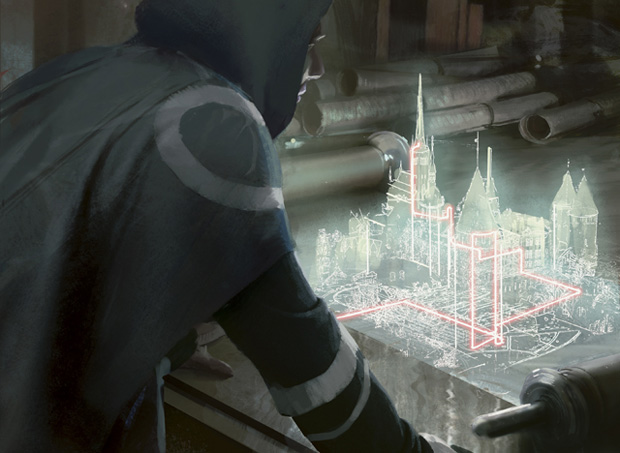
With my recent move and the approach of Pro Tour: Magic Origins in Vancouver, I’ve been focused primarily on two things: Standard, and where my socks are. While I eventually found said socks, I’ve also learned quite a lot about the upcoming Standard format. I imagine that information regarding either of those topics is of little importance to you fine readers, so instead, I figured I’d give an overview of my experiences regarding testing and card evaluation for Pro Tour: Magic Origins. I hope that you can take this information and apply it to your own testing process. (If you would rather hear me wax eloquent on Standard or discuss my super sweet Batman socks, let me know in the comments.) Let’s go!
Large event testing is generally approached in different ways, depending on a few situational/environmental factors going in. Every Pro Tour season I look forward to retrospective articles by pro players regarding their testing process, informational tidbits, and humble brags about their week-long testing vacations, complete with pictures of delicious food and copious amounts of name-dropping. These articles are always fun reads, giving we regular humans a peek behind-the-scenes at the work pros put in to generate their results. We also get to live a little vicariously through their tournament reports. While these articles are definitely informational as far as detailing how testing can be done, I’ve found that a lot of the tactics and techniques large teams employ to figure out a format end up being impossible when attempted by smaller groups. Thus, I’ve come to present an alternative - Testing for the Little Man: An Aspiring Player’s Guide to Getting Better!
[wp_ad_camp_1]
Preface: How Do You Learn?
One thing we need to keep in mind regarding testing is the goal: pursuing knowledge. In the end, we all learn differently, which seems simple, but is essential to remember when giving an overview of testing techniques. For example, I am a visual learner, and tend to zone out when looking at a computer screen. As a result, I usually print out card images and decklists and write handwritten notes for details I need to keep in mind. Other players are auditory learners: they discuss ideas, listen to SCG coverage and tune into podcasts for information. Almost all of us are physical learners to some extent; we need to actually put our hands on the cards and play through games to gain information. How we learn, combined with the tools we have available to us, greatly influences our individual testing process.
From this point forward, I will be detailing the process I use to prepare for events. Remember, this is all from my perspective: a combination of what works best for me and the resources I have available to use.
Step 1: Analyze Level 0 – Form a Foundation
I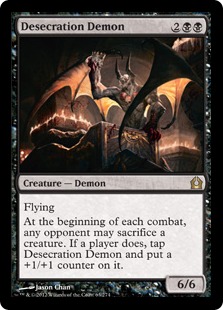 n Magic, everything is context. Level 0 can be anything, from the previous week’s results to the dying breaths of a stale format. Analyzing the context to determine not only what is good/bad, but why is, in my opinion, the best way to gain an entry-level understanding of things as they exist now (Level 0).
n Magic, everything is context. Level 0 can be anything, from the previous week’s results to the dying breaths of a stale format. Analyzing the context to determine not only what is good/bad, but why is, in my opinion, the best way to gain an entry-level understanding of things as they exist now (Level 0).
For example, Desecration Demon in a world of Lingering Souls is downright embarrassing. Remove Thragtusk and the like from the equation, and the “relative worth” of a card like Desecration Demon drastically changes. Shifts like this in the metagame, both on an individual card level and an archetype level, are often surprising and unexpected, but they don’t have to be. Careful evaluation of what is played, what is not, and especially why can help us find those diamonds in the rough, waiting to burst from the shadows when the proper conditions are met.
Step 2: Play Stock Lists
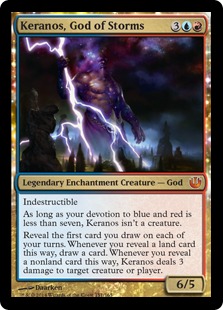 It’s easy for me to get caught up in theory and forget all about what is arguably the best way to learn: playing games! Playing stock lists of Level 0 decks not only gives us experience with the current top decks in the format, it allows us to build on our foundation of understanding about how things operate. Playing various archetypes and matchups (on both sides) provides an understanding about how games play out, general archetype-specific strengths, their weaknesses, and matchup-specific intricacies. Theorycrafting is useful to an extent, but until you actually draw that one-of Keranos, God of Storms floating around in Twin sideboards, you’ll never know if it is better or worse than Bitterblossom, Jace, Architect of Thought, or Olivia Voldaren.
It’s easy for me to get caught up in theory and forget all about what is arguably the best way to learn: playing games! Playing stock lists of Level 0 decks not only gives us experience with the current top decks in the format, it allows us to build on our foundation of understanding about how things operate. Playing various archetypes and matchups (on both sides) provides an understanding about how games play out, general archetype-specific strengths, their weaknesses, and matchup-specific intricacies. Theorycrafting is useful to an extent, but until you actually draw that one-of Keranos, God of Storms floating around in Twin sideboards, you’ll never know if it is better or worse than Bitterblossom, Jace, Architect of Thought, or Olivia Voldaren.
Step 3: What Changes?
 What is done in this stage depends more on environmental factors than anything else. What is happening in the world of Magic: The Gathering at this point? Are you preparing for a Pro Tour? A Grand Prix? FNM? Has a new set just been released? A new B+R announcement? Were there any recent high-profile events? Or, just as importantly, how long has it been since a major event? Answers to these questions influence what needs to be done next, and our testing process will vary wildly depending on these environmental factors. Pro Tours always follow a set release, and as a result, are almost always unexplored formats. For Standard Pro Tours, there is usually one relatively high-profile event preceding the Pro Tour, often an SCG Open. For Grand Prix events, Level 0 could be a week ago or months ago, depending on the format. FNM’s are a different topic entirely, and vary from shop to shop, but generally most players at that level stick to the same two-three decks, with a couple individuals bouncing around from list to list. Measure the volatility, and proceed from there.
What is done in this stage depends more on environmental factors than anything else. What is happening in the world of Magic: The Gathering at this point? Are you preparing for a Pro Tour? A Grand Prix? FNM? Has a new set just been released? A new B+R announcement? Were there any recent high-profile events? Or, just as importantly, how long has it been since a major event? Answers to these questions influence what needs to be done next, and our testing process will vary wildly depending on these environmental factors. Pro Tours always follow a set release, and as a result, are almost always unexplored formats. For Standard Pro Tours, there is usually one relatively high-profile event preceding the Pro Tour, often an SCG Open. For Grand Prix events, Level 0 could be a week ago or months ago, depending on the format. FNM’s are a different topic entirely, and vary from shop to shop, but generally most players at that level stick to the same two-three decks, with a couple individuals bouncing around from list to list. Measure the volatility, and proceed from there.
Step 3b: Analyzing New Sets
The echo chamber around set releases can be constructive or destructive, depending entirely on what type of learner you are. Thanks to Twitter, we can get thousands of opinions on every spoiled 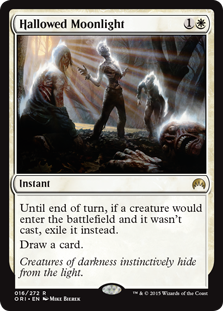 card. Writers for every content site under the sun are tasked to give their take, complete with flashy decklists to feed the spoiler frenzy. For those looking to evaluate new cards and strategies, the road can be dangerous, littered with questions and uncertainty. Should I be trusting this pro’s decklist? What if they suggest 18 of them! How much time went into studying the format? The whole set isn’t even spoiled yet! Where is the context?!? For me, I take it all in, but with a grain of salt.
card. Writers for every content site under the sun are tasked to give their take, complete with flashy decklists to feed the spoiler frenzy. For those looking to evaluate new cards and strategies, the road can be dangerous, littered with questions and uncertainty. Should I be trusting this pro’s decklist? What if they suggest 18 of them! How much time went into studying the format? The whole set isn’t even spoiled yet! Where is the context?!? For me, I take it all in, but with a grain of salt.
As for my own process, I evaluate cards first on rate, then again on context. Hallowed Moonlight is a strong card; a cantrip that provides a powerful effect and can cycle if not needed. As far as context though, what deck in Modern would want this card? Abzan or Jeskai Control? Against Twin, both of these decks have much better options for stopping that angle of attack. Against Living End, Abzan could just play Leyline of the Void, and Jeskai doesn’t need the help. I’m not saying it won’t be good, I’m just saying that every card has two values; what it is capable of, and how it stacks up in the environment.
Step 4: Tactics for Gaining Information
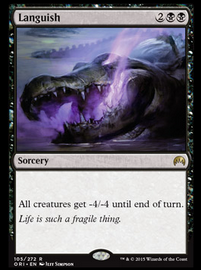 Resources such as product to build/draft from, and physical location can have an impact on what type of testing can be done. Despite these limitations, opportunities to learn are everywhere. When playtesting games, keep a notepad handy to jot down information as you discover it (ex: Frenzied Goblin vs. Zurgo Bellstriker, or Languish sucks vs. Whisperwood Elemental plus a developed board). Little bullet-points will contribute more towards learning how a matchup works than just recording win/loss statistics. Grab a group of friends that are all equally invested in testing and start talking things over. Testing teams can vary in size from a large group of players, a small group of friends or a lone wolf preparing alone.
Resources such as product to build/draft from, and physical location can have an impact on what type of testing can be done. Despite these limitations, opportunities to learn are everywhere. When playtesting games, keep a notepad handy to jot down information as you discover it (ex: Frenzied Goblin vs. Zurgo Bellstriker, or Languish sucks vs. Whisperwood Elemental plus a developed board). Little bullet-points will contribute more towards learning how a matchup works than just recording win/loss statistics. Grab a group of friends that are all equally invested in testing and start talking things over. Testing teams can vary in size from a large group of players, a small group of friends or a lone wolf preparing alone.
For me, I don’t have access to a physical collection of cards, nor an established group of what kids these days call “friends”. As a result, my testing process involves a combination of note-taking, article-reading, and decklist analysis. I also play as many random games with proxied cards as I can find against unfortunate victims at my local store. While I currently lack a testing team to work with, my unique situation as a streamer does provide the advantage of discussing topics with a couple hundred viewers at a time. All of these factors combined can lead to a sort of haphazard collection of information, where decklists, notes, and other details are spread around between my streaming computer, laptop, notebook and random notes on my phone or index cards. This leads me to my next point, which is:
Step 5: Stay Organized!
In the end, the great equalizer regarding testing for events is time. Regardless of situation or resources, we only have a finite amount of time to prepare for events. This means prioritizing time spent testing is the most important thing we can do. Whether you have a week to test or a couple of hours, staying organized reduces the amount of time spent combining and reviewing information/angrily throwing things across the room. I have found that three Word documents tend to do the trick:
- One- A macro-level list of all the decks in the format with major cards/themes, divided into tiers.
- Two- A list of most major decks in the format (basically whatever I’m considering playing) with a sample decklist and detailed notes regarding role, matchup, sideboarding, and problem cards/easily handled cards in the format)
- Three – List of notes, bullet-style, about both the format in general and specific details. Ex: Ashiok, Nightmare Weaver is great vs. a format full of midrange decks and fewer Hero's Downfall, Fulminator Mage is better than Blood Moon when people are sideboarding Nature's Claim or Chromatic Lantern, Tasigur is good vs. Languish and Stoke the Flames.
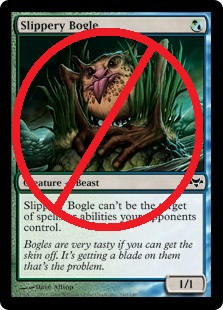 These documents combined help keep me organized and focused as I’m evaluating cards or analyzing the format.
These documents combined help keep me organized and focused as I’m evaluating cards or analyzing the format.
It’s easy to go “too deep” with analysis and forget the context of the format. For example, during the
Modern Festival Finals I briefly considered Bogles as a deck I might be interested in playing; one of the best decks (Grixis) just died to it, and the rest of the format seemed to be weak to enchantments in general. Eventually, I remembered the context that Bogles has huge difficulties against Abzan and Jund, and is actually just a bad deck to begin with. By keeping focused and remembering the context, I played Grixis Control and avoided disaster (and everything else that comes with sleeving up Bogels for an event).
Conclusion
While we all learn differently, and there are many different ways to approach testing, it remains true that “you get out what you put in”. However you test, stay organized, remember context, and don’t be afraid to pursue a lead just because it’s not the most popular option. Everyone says Mizzium Meddler is unplayable, but you’ll never know for sure until you sleeve it up and try it out.
For anyone that’s been watching my stream recently, you know that I just partnered with Twitch. It’s been hectic lately between my move and preparations for the Pro Tour, so I wanted to say thanks for all of your support with the stream! I truly couldn’t have achieved my goal without your help. For those that haven’t stopped by yet, head over to twitch.tv/Architect_Gaming! While I’m spending most of my time off-stream preparing for Pro Tour Magic Origins, we are still playing Modern on stream and looking around for new decks to play.
Next week, I figured I’d try a mailbag-style article; shoot some questions at me in the comments and on Twitter! If you have any opinions/ideas on testing that you think I should know, send me those too! After the Pro Tour, we can get back to Modern discussion. Thanks for reading!
Trevor Holmes
The_Architect on MTGO
Twitch.tv/Architect_Gaming
Twitter.com/7he4rchitect






Love the article and the stream. Keep it up!
“…nor an established group of what kids these days call “friends””. <—- Best line in the article! I am 100% with this! The folks I see on the reg. every FMN are a cool group of people I'm able to bounce ideas off whenever I can.
Thanks for another great article! Reading articles and taking things into consideration is a big help for me since my hands on time is really limited. I'm grateful for all the commentary of hard working Pros and players like yourself that give me insight into the game that I couldn't otherwise get.
Thanks! I’m glad you liked it!
Nice article. I especially like the step-by-step ways to help grasp the meta. I may use it as a primer to try and get my friends back into the game.
As far as stream suggestions… I’d love to see your take on Modern Goblins once you have access to Origins. I think it’s a tribe that could really shine if the proper framework is put together, but there are so many options (AEther Vial aggro, tokens + Shared Animosity, Collected Company/Day’s Undoing, just to name a few) that it’s hard to tell what that “proper framework” is. Any insight on this issue would be very interesting to me.
We will definitely be playing Goblins on stream! I’ve tested it before and the best versions seemed to be low to the ground with Goblin Grenade, it will be interesting to see if/how Piledriver changes things.
I have a question for the mailbag article! When is it correct (or is it ever correct) to play cards in a deck that individually do things the deck wants, but in conjunction they are a bit of a nombo?
A pretty common example in Modern is playing Mana Leak and Path to Exile in the same deck. A more extreme example in Standard is playing Ugin and Banishing Light in the same deck. They both do something the deck wants, but together they are poor to horrendous. Where’s the line there? Is it always dependent on the two cards? Is that just a sign of a bad deck-builder and should never happen?
Hope that’s not too general of a question!
Not at all! That’s a very interesting question, and one that I think I could elaborate on into a whole mini-article at least. Thanks for the question, will definitely be thinking it over!
Excellent as usual!
Hey Trevor,
I’m a big fan of your stream. Wanted to write in with a question as you suggested earlier today:
I’m relatively new to Modern as a format (Playing G/B Obliterator rock), and I know a lot of people talk about how difficult sideboarding in Modern can be. A popular recommendation I’ve received is to “use your sideboard slots to shore up your 2 or 3 worst match-ups, but don’t try to fight everything.”
While this seems like solid advice to me, it also downplays the role of super-utility cards in the sideboard. To clarify, by “super-utility” I mean cards like fulminator mage, relic of progenitus, izzet staticaster, etcetera. They’re perhaps really useful in one particular match-up (infect, living end, tokens) but also can be excellent cards in a variety of match-ups. They’re basically maindeck cards 61-64.
So my question is this: When sideboarding in modern, is it better to fight a narrow range of difficult match-ups or bring “good” cards that play in a variety of match-ups but might not put you back to 50-50 in your worst match-ups?
Best,
Jeff
What cards if any from origins do you expect to see make an impact on modern? And what decks do you see them going in?
For someone coming back into modern after a couple years hiatus, which blue based deck would you recommend for a mage with affinity for islands? also which card on the banlist is most likely to be unbanned, and which card unbanning/banning would make for the most interesting format?
-TJDL
Do you think any deck in modern will be playing Languish, like grixis or junk. Also how do you think the NEW planes walkers will stand up in standard, and modern?
I enjoy reading your articles and watching your stream keep it up
Great article, as another MTG player aspiring to qualify for the pro tour one day, do think that streaming could be used for brainstorming sessions with your viewers? As this may fill the void left by not being part of a big team.
Liked the article! I apply a good majority of these when playtesting. Also glad to see someone with a similar opinion of hallowed moonlight. Great card in theory but there are better more versitle options, unless your meta is all graveyard based.